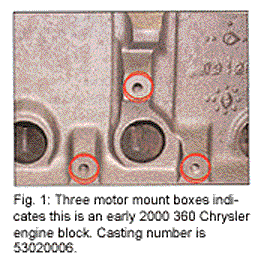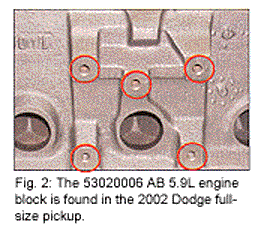In this month’s “Core Corner” I am addressing a potpourri of different issues – some old, some new, but all of them offer something that will keep you out of the “Do Over” column and, of course, profitable. I got the idea from my wife some weeks ago while accompanying her (being dragged) to a number of garage sales (no letters please). My wife can be driving down a major interstate and sniff out a worthwhile garage sale from miles away. Somehow, she always seems to find these gems that others have taken for granted or are tired of.
That is how I feel about this next bit of information. Talk about “taken for granted or tired of;” think of the 350/305 Chevrolet crankshaft. I am talking about the Gen IE engines, which went away in 2003 and were replaced by the Gen III engines.
There have been many bulletins written and different means of attempting to identify the difference between these two. Let’s start with the fact that they both begin with the same casting, which is balanced differently depending on which displacement it is going to be used for. In essence there is only one crankshaft, it’s just drilled differently in the first and rear counterweight.
Until recently I had not heard a definitive solution to the identification of these two crankshafts. But since this information was based upon the sorting of over 600 crankshafts I feel that the school of “hard knocks” which once again has prevailed can now lift the shadow of uncertainty.
Here’s the identification secret. If the collective dimension of the drilled balance holes between the first and rear counter weight is 2-3/4? or less it is a 350 and if the collective depth is 3-1/4? or more it is a 305. The one exception is the Gen II LT1 350 crankshaft. So pull out your trusty pocket ruler, measure, add and that should be all that you need for a positive identification.

Next I am going to talk about a couple of engine blocks that changed right before their demise. Let’s start with the 5.9L/360 cid Chrysler. Somewhere in 2000 the 360 Chrysler engine block got a few extra motor mount bosses added to it (see Figure 1). The block now has five vs. the former three. This was done so that the 360 could be used in a common platform with the new 4.7L engine.
When encountering this block you will notice that the casting number is the same (c/n 53020006) but an AB suffix has been added. The best information that we have at this point says the only application that requires the additional bolt bosses is the 2002 Dodge Ram full-size pickup. So make certain that you have the correct block in that application; otherwise the 3-bolt motor mount block may be used. And after 2002 the 360 is gone so you won’t have to worry about it anymore.

The last block I want to talk about is the 5.7L/350 Chevrolet that also went through changes in the year 2000. In 1999 the 4.3L Chevrolet engine block went metric on the motor mount, transmission mount and starter bolt. Additionally the block casting number had an “M” suffix added. That makes the identification easy and clean.
Not so on the 350. In 2000 the block went metric in the same places as the 4.3L but there is no identifier to indicate it as such. The other problem is that it does not seem to be applicable to all platforms.
The one thing that can be said for certain is when used in the Isuzu trucks it is always a metric block. For all other platforms you better get identification/verification prior to threads being stripped or torn out.
The last twist to the 350 block is that the service replacement blocks are manufactured in Mexico and they are all standard thread and not metric. The obvious becomes apparent; if you had a metric block and you purchase a new service replacement you have trouble.
This type of information will be available to everyone beginning Oct. 1, 2004 through EngineData-Source.com a fully web-based engine remanufacturer/builder critical data and casting identification resource. Watch for the official release information.
For technical questions, contact the Production Engine Remanufacturers Association (PERA) at: [email protected].













